Nursing Teaching Plan Report: Parkinson's Disease Training Program
VerifiedAdded on 2022/09/09
|14
|4101
|71
Report
AI Summary
This report presents a comprehensive nursing teaching plan focusing on Parkinson's disease, designed for second-year nursing students. The teaching session, conducted as a 2-hour lecture for 115 students, utilized a social constructivism learning theory to promote knowledge integration and collaboration. The report analyzes the effectiveness of the lecture strategy, discussing its strengths in providing direct communication and structured information, while also acknowledging its limitations regarding individual student needs and feedback. The analysis includes student feedback, highlighting both positive aspects such as the informative and customized content, and negative aspects such as the large class size. The reflection section discusses the author's learning from the session, emphasizing the importance of smaller batch sizes for future teaching programs to ensure clarity and precision in delivering complex medical information. The report concludes with a discussion of assessment methods and future developmental goals, emphasizing the need for continuous improvement in teaching strategies to meet the evolving needs of nursing education.
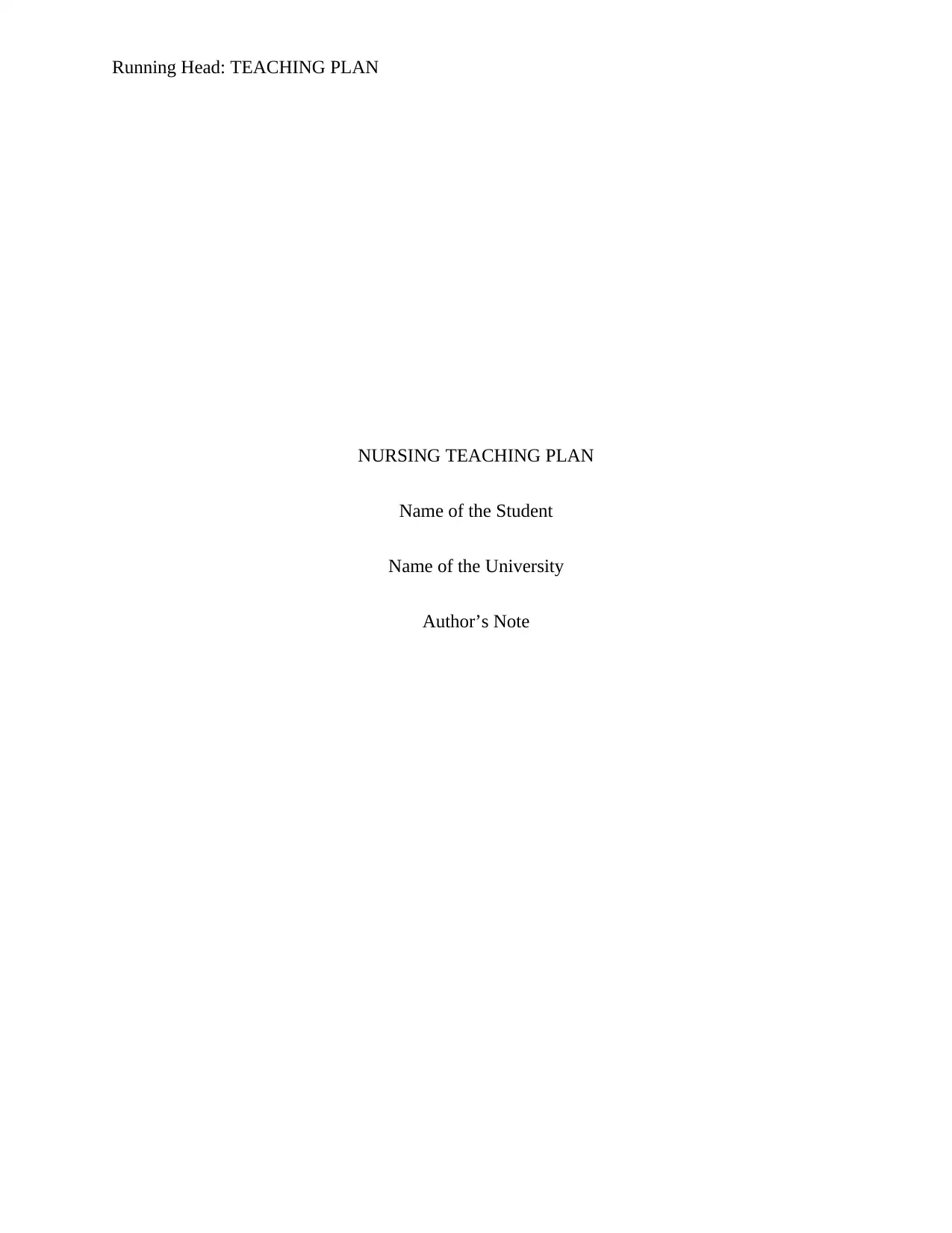
Running Head: TEACHING PLAN
NURSING TEACHING PLAN
Name of the Student
Name of the University
Author’s Note
NURSING TEACHING PLAN
Name of the Student
Name of the University
Author’s Note
Paraphrase This Document
Need a fresh take? Get an instant paraphrase of this document with our AI Paraphraser
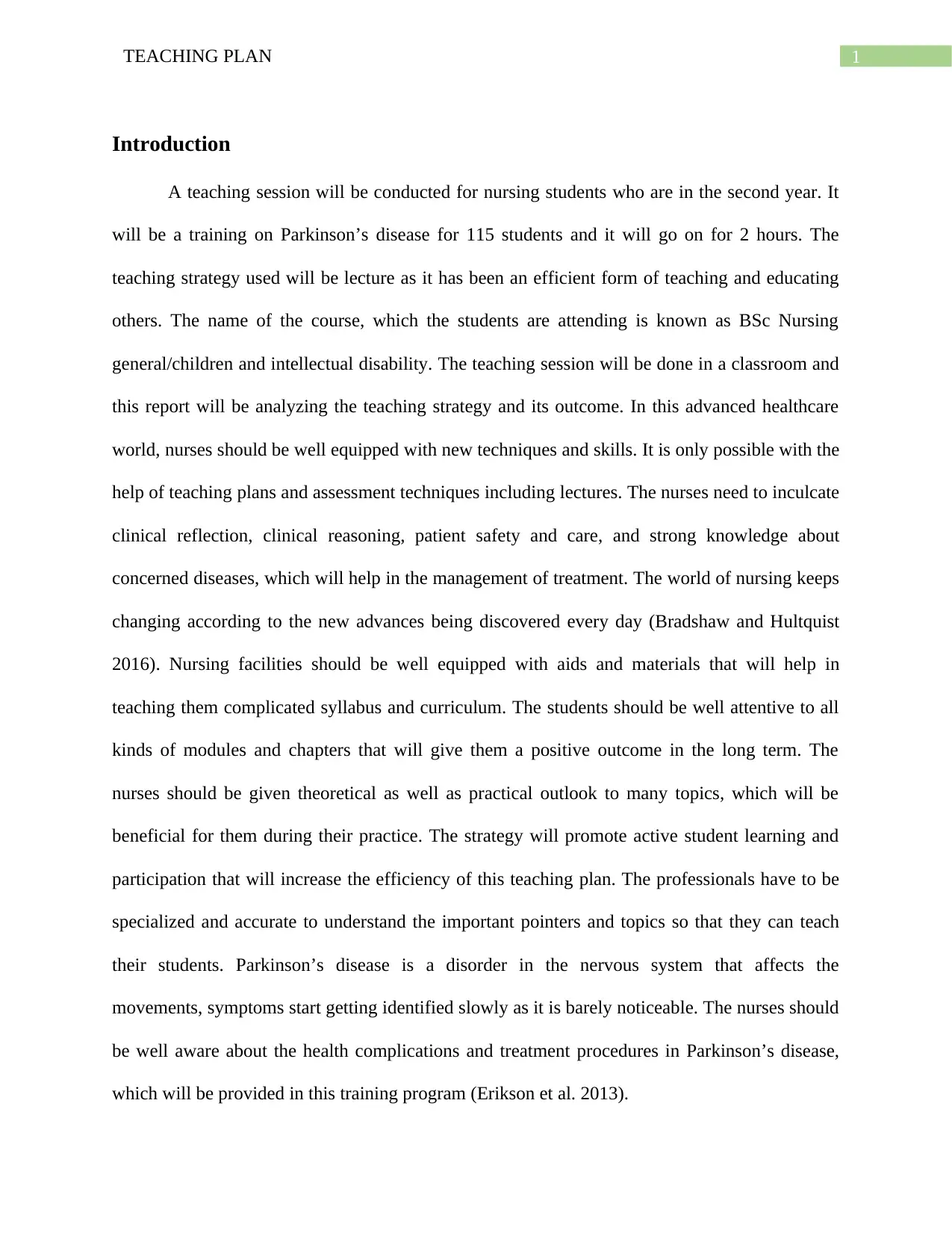
1TEACHING PLAN
Introduction
A teaching session will be conducted for nursing students who are in the second year. It
will be a training on Parkinson’s disease for 115 students and it will go on for 2 hours. The
teaching strategy used will be lecture as it has been an efficient form of teaching and educating
others. The name of the course, which the students are attending is known as BSc Nursing
general/children and intellectual disability. The teaching session will be done in a classroom and
this report will be analyzing the teaching strategy and its outcome. In this advanced healthcare
world, nurses should be well equipped with new techniques and skills. It is only possible with the
help of teaching plans and assessment techniques including lectures. The nurses need to inculcate
clinical reflection, clinical reasoning, patient safety and care, and strong knowledge about
concerned diseases, which will help in the management of treatment. The world of nursing keeps
changing according to the new advances being discovered every day (Bradshaw and Hultquist
2016). Nursing facilities should be well equipped with aids and materials that will help in
teaching them complicated syllabus and curriculum. The students should be well attentive to all
kinds of modules and chapters that will give them a positive outcome in the long term. The
nurses should be given theoretical as well as practical outlook to many topics, which will be
beneficial for them during their practice. The strategy will promote active student learning and
participation that will increase the efficiency of this teaching plan. The professionals have to be
specialized and accurate to understand the important pointers and topics so that they can teach
their students. Parkinson’s disease is a disorder in the nervous system that affects the
movements, symptoms start getting identified slowly as it is barely noticeable. The nurses should
be well aware about the health complications and treatment procedures in Parkinson’s disease,
which will be provided in this training program (Erikson et al. 2013).
Introduction
A teaching session will be conducted for nursing students who are in the second year. It
will be a training on Parkinson’s disease for 115 students and it will go on for 2 hours. The
teaching strategy used will be lecture as it has been an efficient form of teaching and educating
others. The name of the course, which the students are attending is known as BSc Nursing
general/children and intellectual disability. The teaching session will be done in a classroom and
this report will be analyzing the teaching strategy and its outcome. In this advanced healthcare
world, nurses should be well equipped with new techniques and skills. It is only possible with the
help of teaching plans and assessment techniques including lectures. The nurses need to inculcate
clinical reflection, clinical reasoning, patient safety and care, and strong knowledge about
concerned diseases, which will help in the management of treatment. The world of nursing keeps
changing according to the new advances being discovered every day (Bradshaw and Hultquist
2016). Nursing facilities should be well equipped with aids and materials that will help in
teaching them complicated syllabus and curriculum. The students should be well attentive to all
kinds of modules and chapters that will give them a positive outcome in the long term. The
nurses should be given theoretical as well as practical outlook to many topics, which will be
beneficial for them during their practice. The strategy will promote active student learning and
participation that will increase the efficiency of this teaching plan. The professionals have to be
specialized and accurate to understand the important pointers and topics so that they can teach
their students. Parkinson’s disease is a disorder in the nervous system that affects the
movements, symptoms start getting identified slowly as it is barely noticeable. The nurses should
be well aware about the health complications and treatment procedures in Parkinson’s disease,
which will be provided in this training program (Erikson et al. 2013).
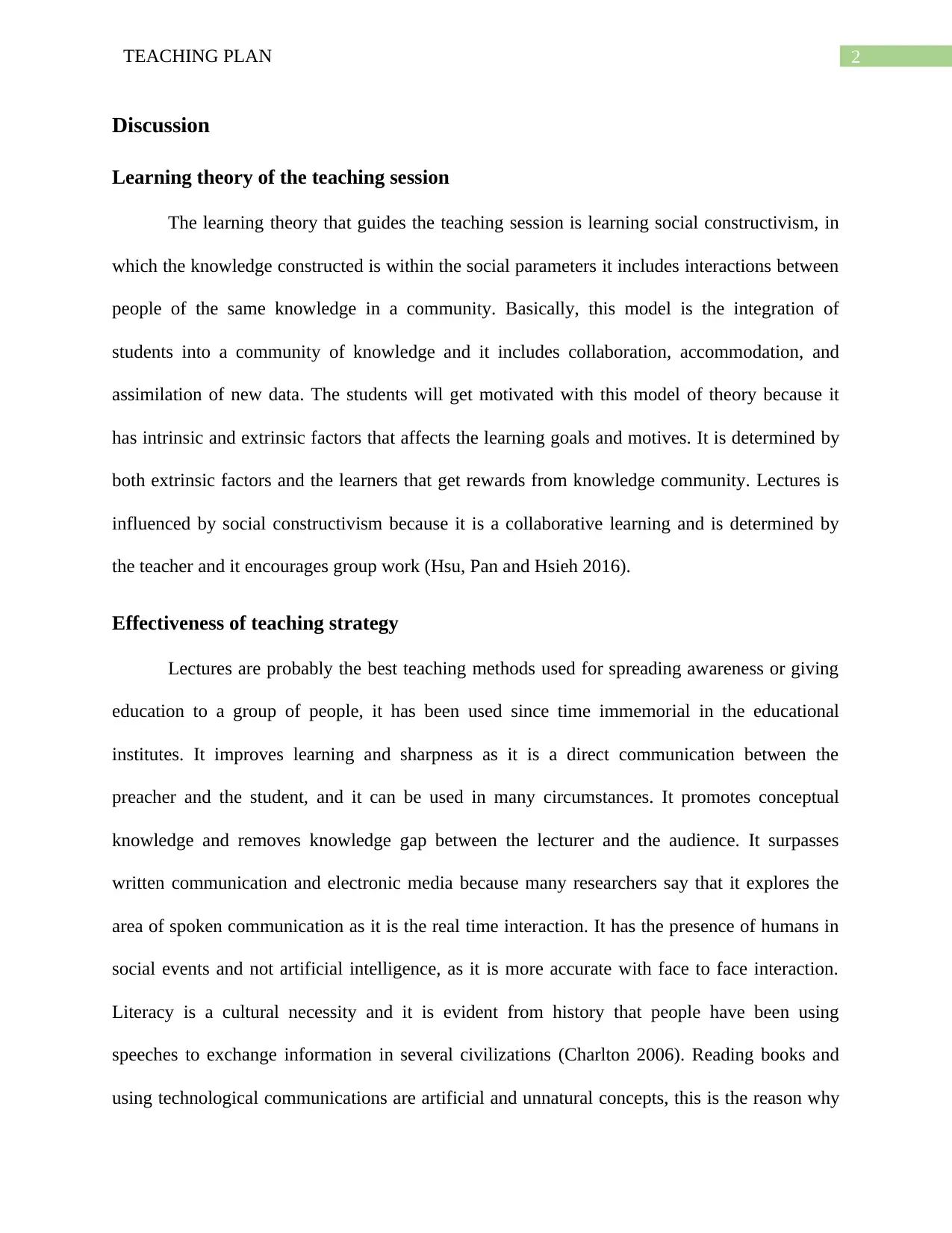
2TEACHING PLAN
Discussion
Learning theory of the teaching session
The learning theory that guides the teaching session is learning social constructivism, in
which the knowledge constructed is within the social parameters it includes interactions between
people of the same knowledge in a community. Basically, this model is the integration of
students into a community of knowledge and it includes collaboration, accommodation, and
assimilation of new data. The students will get motivated with this model of theory because it
has intrinsic and extrinsic factors that affects the learning goals and motives. It is determined by
both extrinsic factors and the learners that get rewards from knowledge community. Lectures is
influenced by social constructivism because it is a collaborative learning and is determined by
the teacher and it encourages group work (Hsu, Pan and Hsieh 2016).
Effectiveness of teaching strategy
Lectures are probably the best teaching methods used for spreading awareness or giving
education to a group of people, it has been used since time immemorial in the educational
institutes. It improves learning and sharpness as it is a direct communication between the
preacher and the student, and it can be used in many circumstances. It promotes conceptual
knowledge and removes knowledge gap between the lecturer and the audience. It surpasses
written communication and electronic media because many researchers say that it explores the
area of spoken communication as it is the real time interaction. It has the presence of humans in
social events and not artificial intelligence, as it is more accurate with face to face interaction.
Literacy is a cultural necessity and it is evident from history that people have been using
speeches to exchange information in several civilizations (Charlton 2006). Reading books and
using technological communications are artificial and unnatural concepts, this is the reason why
Discussion
Learning theory of the teaching session
The learning theory that guides the teaching session is learning social constructivism, in
which the knowledge constructed is within the social parameters it includes interactions between
people of the same knowledge in a community. Basically, this model is the integration of
students into a community of knowledge and it includes collaboration, accommodation, and
assimilation of new data. The students will get motivated with this model of theory because it
has intrinsic and extrinsic factors that affects the learning goals and motives. It is determined by
both extrinsic factors and the learners that get rewards from knowledge community. Lectures is
influenced by social constructivism because it is a collaborative learning and is determined by
the teacher and it encourages group work (Hsu, Pan and Hsieh 2016).
Effectiveness of teaching strategy
Lectures are probably the best teaching methods used for spreading awareness or giving
education to a group of people, it has been used since time immemorial in the educational
institutes. It improves learning and sharpness as it is a direct communication between the
preacher and the student, and it can be used in many circumstances. It promotes conceptual
knowledge and removes knowledge gap between the lecturer and the audience. It surpasses
written communication and electronic media because many researchers say that it explores the
area of spoken communication as it is the real time interaction. It has the presence of humans in
social events and not artificial intelligence, as it is more accurate with face to face interaction.
Literacy is a cultural necessity and it is evident from history that people have been using
speeches to exchange information in several civilizations (Charlton 2006). Reading books and
using technological communications are artificial and unnatural concepts, this is the reason why
⊘ This is a preview!⊘
Do you want full access?
Subscribe today to unlock all pages.

Trusted by 1+ million students worldwide
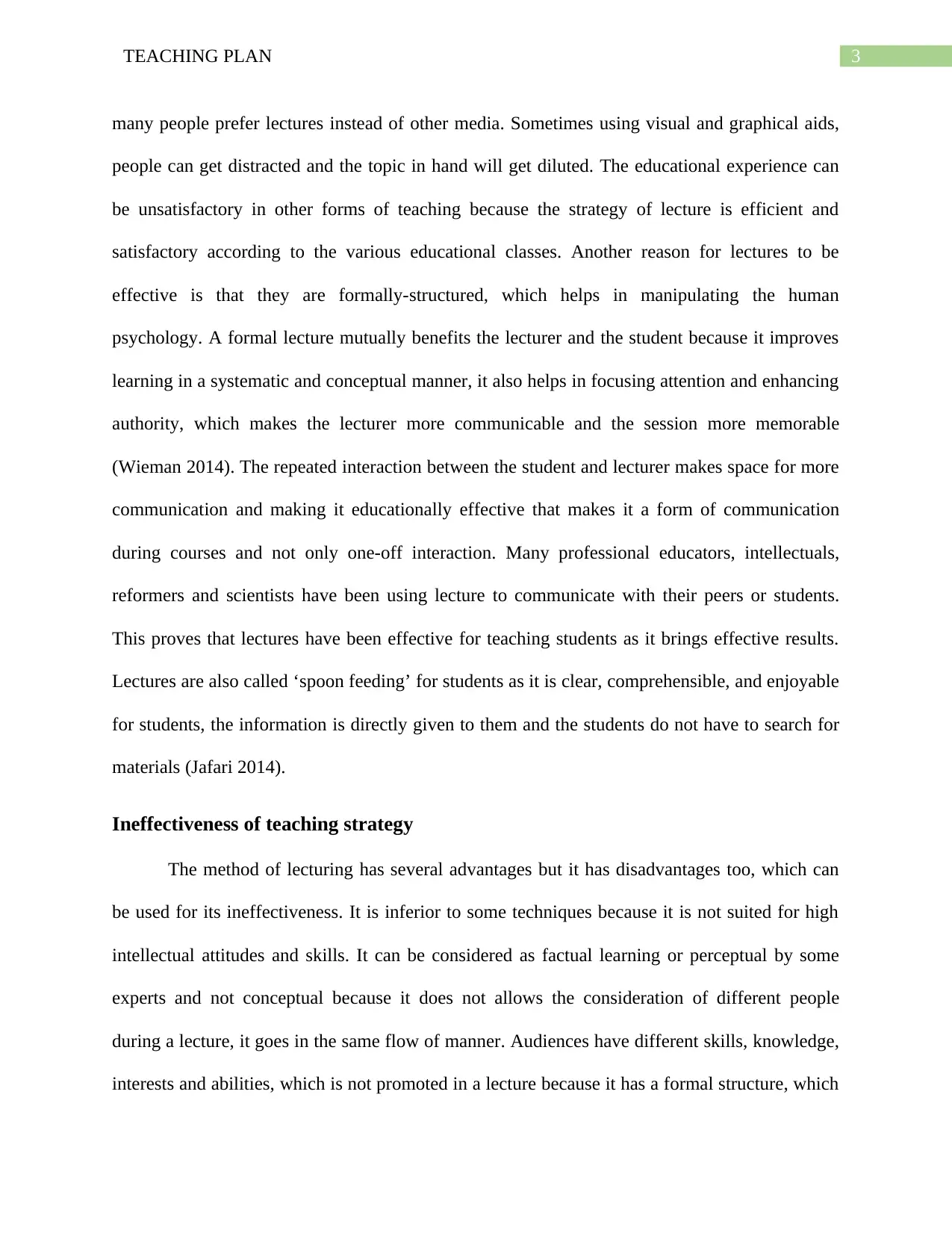
3TEACHING PLAN
many people prefer lectures instead of other media. Sometimes using visual and graphical aids,
people can get distracted and the topic in hand will get diluted. The educational experience can
be unsatisfactory in other forms of teaching because the strategy of lecture is efficient and
satisfactory according to the various educational classes. Another reason for lectures to be
effective is that they are formally-structured, which helps in manipulating the human
psychology. A formal lecture mutually benefits the lecturer and the student because it improves
learning in a systematic and conceptual manner, it also helps in focusing attention and enhancing
authority, which makes the lecturer more communicable and the session more memorable
(Wieman 2014). The repeated interaction between the student and lecturer makes space for more
communication and making it educationally effective that makes it a form of communication
during courses and not only one-off interaction. Many professional educators, intellectuals,
reformers and scientists have been using lecture to communicate with their peers or students.
This proves that lectures have been effective for teaching students as it brings effective results.
Lectures are also called ‘spoon feeding’ for students as it is clear, comprehensible, and enjoyable
for students, the information is directly given to them and the students do not have to search for
materials (Jafari 2014).
Ineffectiveness of teaching strategy
The method of lecturing has several advantages but it has disadvantages too, which can
be used for its ineffectiveness. It is inferior to some techniques because it is not suited for high
intellectual attitudes and skills. It can be considered as factual learning or perceptual by some
experts and not conceptual because it does not allows the consideration of different people
during a lecture, it goes in the same flow of manner. Audiences have different skills, knowledge,
interests and abilities, which is not promoted in a lecture because it has a formal structure, which
many people prefer lectures instead of other media. Sometimes using visual and graphical aids,
people can get distracted and the topic in hand will get diluted. The educational experience can
be unsatisfactory in other forms of teaching because the strategy of lecture is efficient and
satisfactory according to the various educational classes. Another reason for lectures to be
effective is that they are formally-structured, which helps in manipulating the human
psychology. A formal lecture mutually benefits the lecturer and the student because it improves
learning in a systematic and conceptual manner, it also helps in focusing attention and enhancing
authority, which makes the lecturer more communicable and the session more memorable
(Wieman 2014). The repeated interaction between the student and lecturer makes space for more
communication and making it educationally effective that makes it a form of communication
during courses and not only one-off interaction. Many professional educators, intellectuals,
reformers and scientists have been using lecture to communicate with their peers or students.
This proves that lectures have been effective for teaching students as it brings effective results.
Lectures are also called ‘spoon feeding’ for students as it is clear, comprehensible, and enjoyable
for students, the information is directly given to them and the students do not have to search for
materials (Jafari 2014).
Ineffectiveness of teaching strategy
The method of lecturing has several advantages but it has disadvantages too, which can
be used for its ineffectiveness. It is inferior to some techniques because it is not suited for high
intellectual attitudes and skills. It can be considered as factual learning or perceptual by some
experts and not conceptual because it does not allows the consideration of different people
during a lecture, it goes in the same flow of manner. Audiences have different skills, knowledge,
interests and abilities, which is not promoted in a lecture because it has a formal structure, which
Paraphrase This Document
Need a fresh take? Get an instant paraphrase of this document with our AI Paraphraser
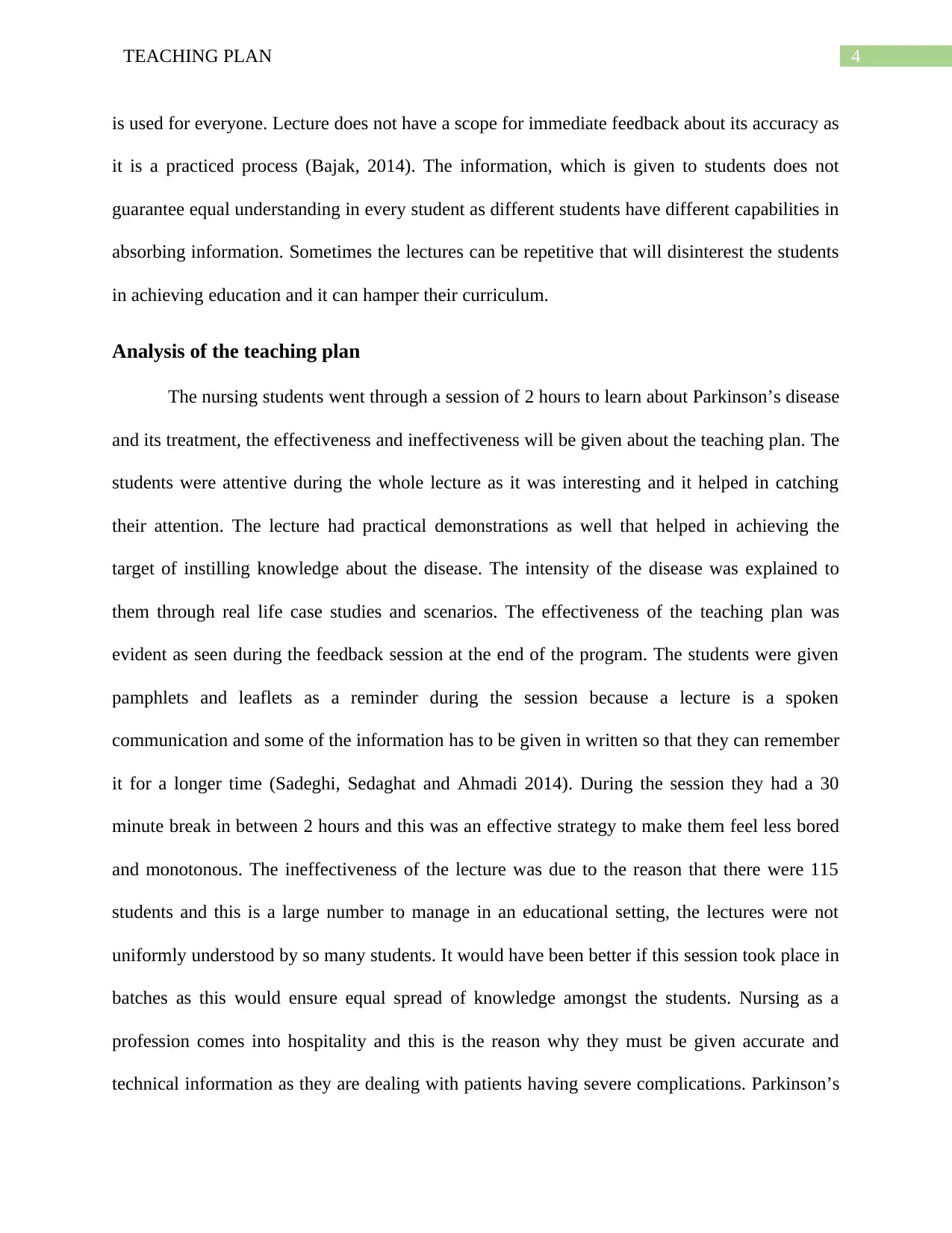
4TEACHING PLAN
is used for everyone. Lecture does not have a scope for immediate feedback about its accuracy as
it is a practiced process (Bajak, 2014). The information, which is given to students does not
guarantee equal understanding in every student as different students have different capabilities in
absorbing information. Sometimes the lectures can be repetitive that will disinterest the students
in achieving education and it can hamper their curriculum.
Analysis of the teaching plan
The nursing students went through a session of 2 hours to learn about Parkinson’s disease
and its treatment, the effectiveness and ineffectiveness will be given about the teaching plan. The
students were attentive during the whole lecture as it was interesting and it helped in catching
their attention. The lecture had practical demonstrations as well that helped in achieving the
target of instilling knowledge about the disease. The intensity of the disease was explained to
them through real life case studies and scenarios. The effectiveness of the teaching plan was
evident as seen during the feedback session at the end of the program. The students were given
pamphlets and leaflets as a reminder during the session because a lecture is a spoken
communication and some of the information has to be given in written so that they can remember
it for a longer time (Sadeghi, Sedaghat and Ahmadi 2014). During the session they had a 30
minute break in between 2 hours and this was an effective strategy to make them feel less bored
and monotonous. The ineffectiveness of the lecture was due to the reason that there were 115
students and this is a large number to manage in an educational setting, the lectures were not
uniformly understood by so many students. It would have been better if this session took place in
batches as this would ensure equal spread of knowledge amongst the students. Nursing as a
profession comes into hospitality and this is the reason why they must be given accurate and
technical information as they are dealing with patients having severe complications. Parkinson’s
is used for everyone. Lecture does not have a scope for immediate feedback about its accuracy as
it is a practiced process (Bajak, 2014). The information, which is given to students does not
guarantee equal understanding in every student as different students have different capabilities in
absorbing information. Sometimes the lectures can be repetitive that will disinterest the students
in achieving education and it can hamper their curriculum.
Analysis of the teaching plan
The nursing students went through a session of 2 hours to learn about Parkinson’s disease
and its treatment, the effectiveness and ineffectiveness will be given about the teaching plan. The
students were attentive during the whole lecture as it was interesting and it helped in catching
their attention. The lecture had practical demonstrations as well that helped in achieving the
target of instilling knowledge about the disease. The intensity of the disease was explained to
them through real life case studies and scenarios. The effectiveness of the teaching plan was
evident as seen during the feedback session at the end of the program. The students were given
pamphlets and leaflets as a reminder during the session because a lecture is a spoken
communication and some of the information has to be given in written so that they can remember
it for a longer time (Sadeghi, Sedaghat and Ahmadi 2014). During the session they had a 30
minute break in between 2 hours and this was an effective strategy to make them feel less bored
and monotonous. The ineffectiveness of the lecture was due to the reason that there were 115
students and this is a large number to manage in an educational setting, the lectures were not
uniformly understood by so many students. It would have been better if this session took place in
batches as this would ensure equal spread of knowledge amongst the students. Nursing as a
profession comes into hospitality and this is the reason why they must be given accurate and
technical information as they are dealing with patients having severe complications. Parkinson’s
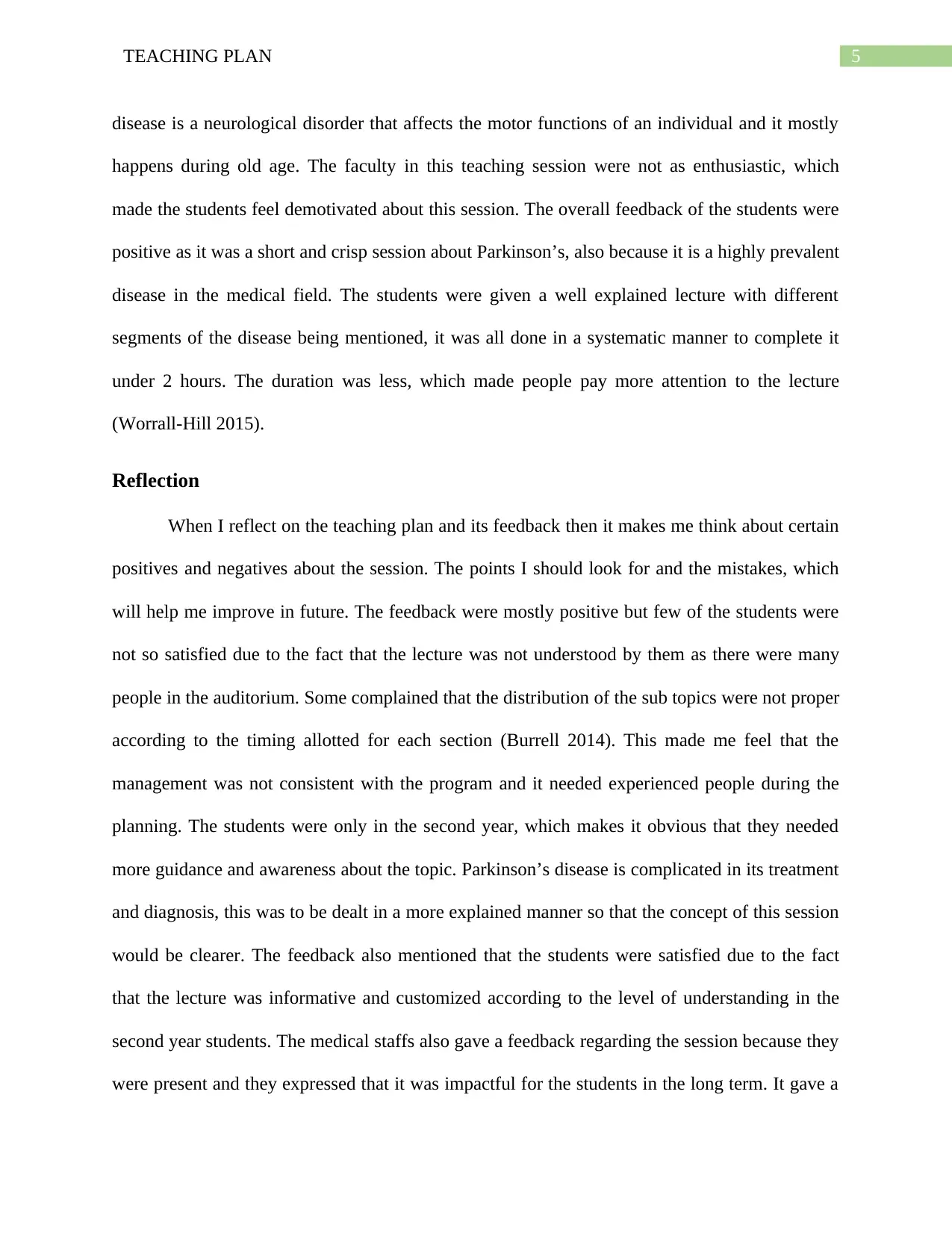
5TEACHING PLAN
disease is a neurological disorder that affects the motor functions of an individual and it mostly
happens during old age. The faculty in this teaching session were not as enthusiastic, which
made the students feel demotivated about this session. The overall feedback of the students were
positive as it was a short and crisp session about Parkinson’s, also because it is a highly prevalent
disease in the medical field. The students were given a well explained lecture with different
segments of the disease being mentioned, it was all done in a systematic manner to complete it
under 2 hours. The duration was less, which made people pay more attention to the lecture
(Worrall-Hill 2015).
Reflection
When I reflect on the teaching plan and its feedback then it makes me think about certain
positives and negatives about the session. The points I should look for and the mistakes, which
will help me improve in future. The feedback were mostly positive but few of the students were
not so satisfied due to the fact that the lecture was not understood by them as there were many
people in the auditorium. Some complained that the distribution of the sub topics were not proper
according to the timing allotted for each section (Burrell 2014). This made me feel that the
management was not consistent with the program and it needed experienced people during the
planning. The students were only in the second year, which makes it obvious that they needed
more guidance and awareness about the topic. Parkinson’s disease is complicated in its treatment
and diagnosis, this was to be dealt in a more explained manner so that the concept of this session
would be clearer. The feedback also mentioned that the students were satisfied due to the fact
that the lecture was informative and customized according to the level of understanding in the
second year students. The medical staffs also gave a feedback regarding the session because they
were present and they expressed that it was impactful for the students in the long term. It gave a
disease is a neurological disorder that affects the motor functions of an individual and it mostly
happens during old age. The faculty in this teaching session were not as enthusiastic, which
made the students feel demotivated about this session. The overall feedback of the students were
positive as it was a short and crisp session about Parkinson’s, also because it is a highly prevalent
disease in the medical field. The students were given a well explained lecture with different
segments of the disease being mentioned, it was all done in a systematic manner to complete it
under 2 hours. The duration was less, which made people pay more attention to the lecture
(Worrall-Hill 2015).
Reflection
When I reflect on the teaching plan and its feedback then it makes me think about certain
positives and negatives about the session. The points I should look for and the mistakes, which
will help me improve in future. The feedback were mostly positive but few of the students were
not so satisfied due to the fact that the lecture was not understood by them as there were many
people in the auditorium. Some complained that the distribution of the sub topics were not proper
according to the timing allotted for each section (Burrell 2014). This made me feel that the
management was not consistent with the program and it needed experienced people during the
planning. The students were only in the second year, which makes it obvious that they needed
more guidance and awareness about the topic. Parkinson’s disease is complicated in its treatment
and diagnosis, this was to be dealt in a more explained manner so that the concept of this session
would be clearer. The feedback also mentioned that the students were satisfied due to the fact
that the lecture was informative and customized according to the level of understanding in the
second year students. The medical staffs also gave a feedback regarding the session because they
were present and they expressed that it was impactful for the students in the long term. It gave a
⊘ This is a preview!⊘
Do you want full access?
Subscribe today to unlock all pages.

Trusted by 1+ million students worldwide
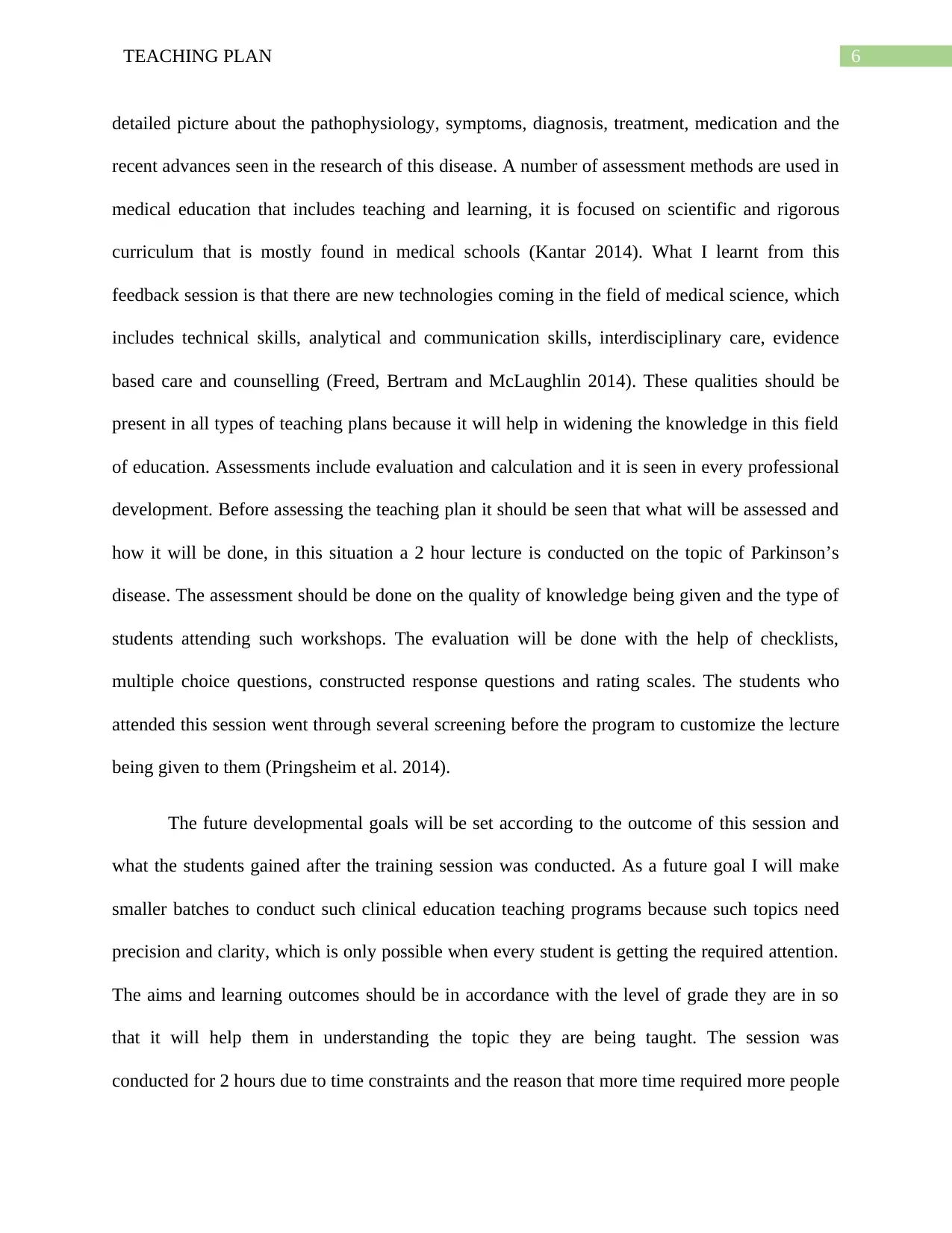
6TEACHING PLAN
detailed picture about the pathophysiology, symptoms, diagnosis, treatment, medication and the
recent advances seen in the research of this disease. A number of assessment methods are used in
medical education that includes teaching and learning, it is focused on scientific and rigorous
curriculum that is mostly found in medical schools (Kantar 2014). What I learnt from this
feedback session is that there are new technologies coming in the field of medical science, which
includes technical skills, analytical and communication skills, interdisciplinary care, evidence
based care and counselling (Freed, Bertram and McLaughlin 2014). These qualities should be
present in all types of teaching plans because it will help in widening the knowledge in this field
of education. Assessments include evaluation and calculation and it is seen in every professional
development. Before assessing the teaching plan it should be seen that what will be assessed and
how it will be done, in this situation a 2 hour lecture is conducted on the topic of Parkinson’s
disease. The assessment should be done on the quality of knowledge being given and the type of
students attending such workshops. The evaluation will be done with the help of checklists,
multiple choice questions, constructed response questions and rating scales. The students who
attended this session went through several screening before the program to customize the lecture
being given to them (Pringsheim et al. 2014).
The future developmental goals will be set according to the outcome of this session and
what the students gained after the training session was conducted. As a future goal I will make
smaller batches to conduct such clinical education teaching programs because such topics need
precision and clarity, which is only possible when every student is getting the required attention.
The aims and learning outcomes should be in accordance with the level of grade they are in so
that it will help them in understanding the topic they are being taught. The session was
conducted for 2 hours due to time constraints and the reason that more time required more people
detailed picture about the pathophysiology, symptoms, diagnosis, treatment, medication and the
recent advances seen in the research of this disease. A number of assessment methods are used in
medical education that includes teaching and learning, it is focused on scientific and rigorous
curriculum that is mostly found in medical schools (Kantar 2014). What I learnt from this
feedback session is that there are new technologies coming in the field of medical science, which
includes technical skills, analytical and communication skills, interdisciplinary care, evidence
based care and counselling (Freed, Bertram and McLaughlin 2014). These qualities should be
present in all types of teaching plans because it will help in widening the knowledge in this field
of education. Assessments include evaluation and calculation and it is seen in every professional
development. Before assessing the teaching plan it should be seen that what will be assessed and
how it will be done, in this situation a 2 hour lecture is conducted on the topic of Parkinson’s
disease. The assessment should be done on the quality of knowledge being given and the type of
students attending such workshops. The evaluation will be done with the help of checklists,
multiple choice questions, constructed response questions and rating scales. The students who
attended this session went through several screening before the program to customize the lecture
being given to them (Pringsheim et al. 2014).
The future developmental goals will be set according to the outcome of this session and
what the students gained after the training session was conducted. As a future goal I will make
smaller batches to conduct such clinical education teaching programs because such topics need
precision and clarity, which is only possible when every student is getting the required attention.
The aims and learning outcomes should be in accordance with the level of grade they are in so
that it will help them in understanding the topic they are being taught. The session was
conducted for 2 hours due to time constraints and the reason that more time required more people
Paraphrase This Document
Need a fresh take? Get an instant paraphrase of this document with our AI Paraphraser
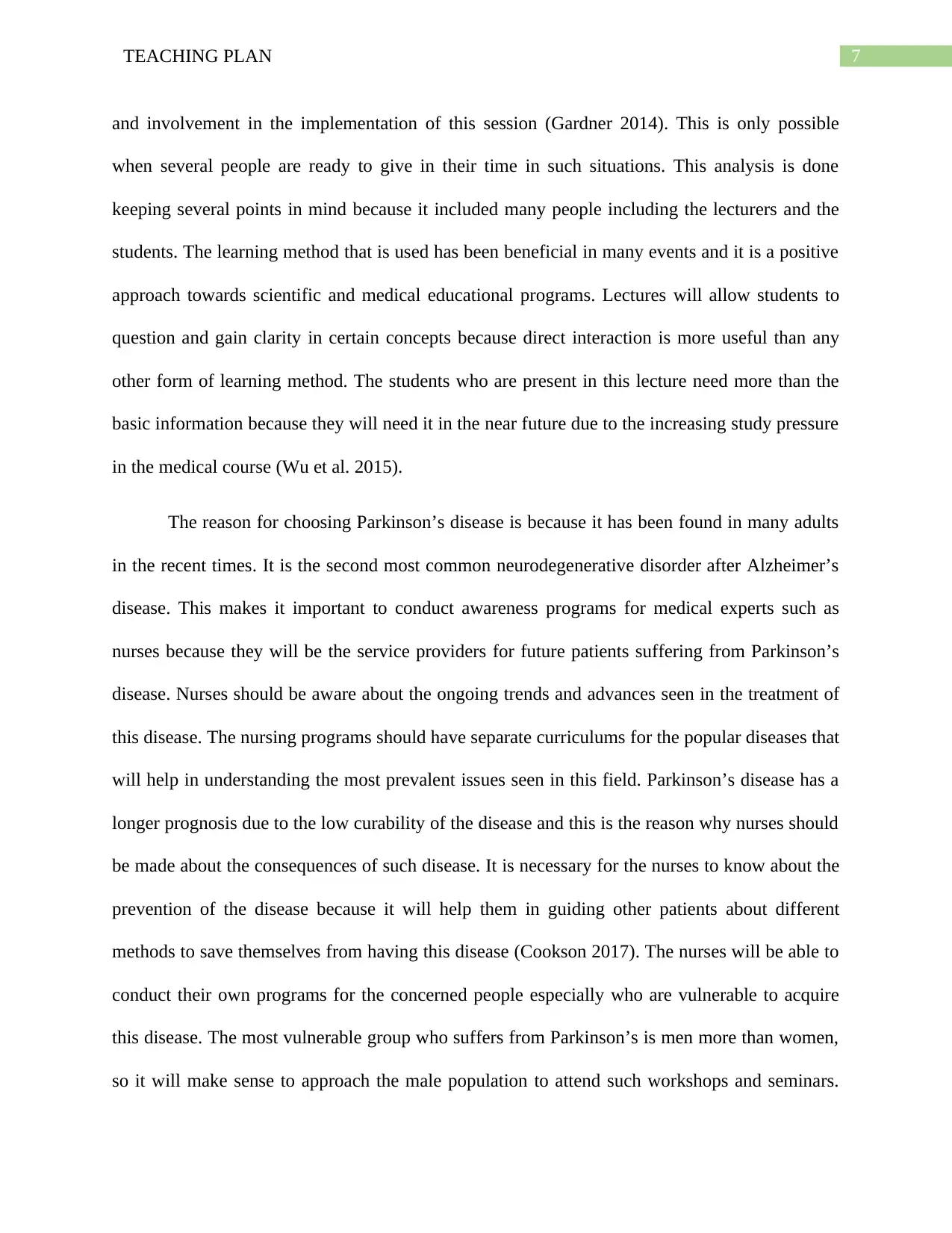
7TEACHING PLAN
and involvement in the implementation of this session (Gardner 2014). This is only possible
when several people are ready to give in their time in such situations. This analysis is done
keeping several points in mind because it included many people including the lecturers and the
students. The learning method that is used has been beneficial in many events and it is a positive
approach towards scientific and medical educational programs. Lectures will allow students to
question and gain clarity in certain concepts because direct interaction is more useful than any
other form of learning method. The students who are present in this lecture need more than the
basic information because they will need it in the near future due to the increasing study pressure
in the medical course (Wu et al. 2015).
The reason for choosing Parkinson’s disease is because it has been found in many adults
in the recent times. It is the second most common neurodegenerative disorder after Alzheimer’s
disease. This makes it important to conduct awareness programs for medical experts such as
nurses because they will be the service providers for future patients suffering from Parkinson’s
disease. Nurses should be aware about the ongoing trends and advances seen in the treatment of
this disease. The nursing programs should have separate curriculums for the popular diseases that
will help in understanding the most prevalent issues seen in this field. Parkinson’s disease has a
longer prognosis due to the low curability of the disease and this is the reason why nurses should
be made about the consequences of such disease. It is necessary for the nurses to know about the
prevention of the disease because it will help them in guiding other patients about different
methods to save themselves from having this disease (Cookson 2017). The nurses will be able to
conduct their own programs for the concerned people especially who are vulnerable to acquire
this disease. The most vulnerable group who suffers from Parkinson’s is men more than women,
so it will make sense to approach the male population to attend such workshops and seminars.
and involvement in the implementation of this session (Gardner 2014). This is only possible
when several people are ready to give in their time in such situations. This analysis is done
keeping several points in mind because it included many people including the lecturers and the
students. The learning method that is used has been beneficial in many events and it is a positive
approach towards scientific and medical educational programs. Lectures will allow students to
question and gain clarity in certain concepts because direct interaction is more useful than any
other form of learning method. The students who are present in this lecture need more than the
basic information because they will need it in the near future due to the increasing study pressure
in the medical course (Wu et al. 2015).
The reason for choosing Parkinson’s disease is because it has been found in many adults
in the recent times. It is the second most common neurodegenerative disorder after Alzheimer’s
disease. This makes it important to conduct awareness programs for medical experts such as
nurses because they will be the service providers for future patients suffering from Parkinson’s
disease. Nurses should be aware about the ongoing trends and advances seen in the treatment of
this disease. The nursing programs should have separate curriculums for the popular diseases that
will help in understanding the most prevalent issues seen in this field. Parkinson’s disease has a
longer prognosis due to the low curability of the disease and this is the reason why nurses should
be made about the consequences of such disease. It is necessary for the nurses to know about the
prevention of the disease because it will help them in guiding other patients about different
methods to save themselves from having this disease (Cookson 2017). The nurses will be able to
conduct their own programs for the concerned people especially who are vulnerable to acquire
this disease. The most vulnerable group who suffers from Parkinson’s is men more than women,
so it will make sense to approach the male population to attend such workshops and seminars.
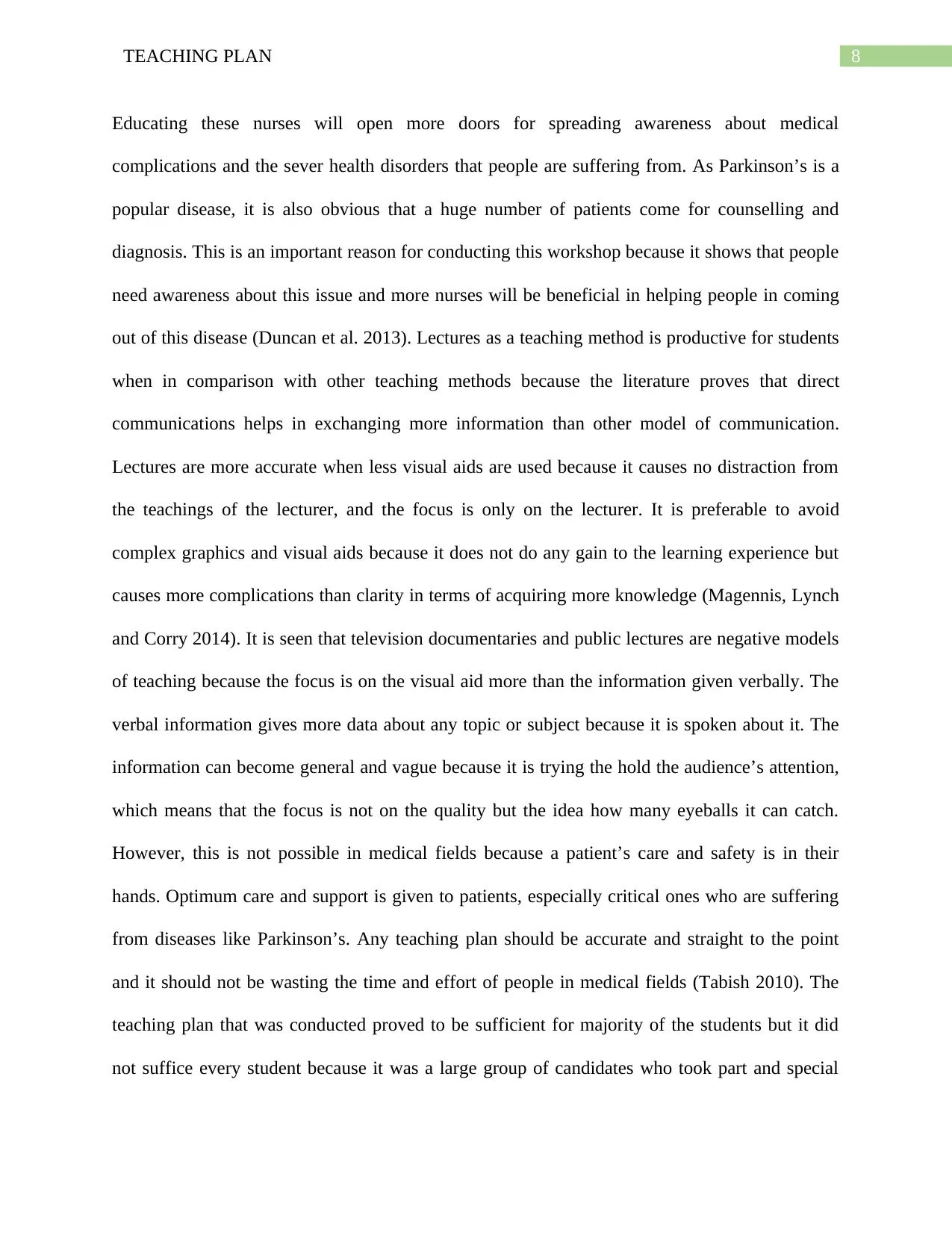
8TEACHING PLAN
Educating these nurses will open more doors for spreading awareness about medical
complications and the sever health disorders that people are suffering from. As Parkinson’s is a
popular disease, it is also obvious that a huge number of patients come for counselling and
diagnosis. This is an important reason for conducting this workshop because it shows that people
need awareness about this issue and more nurses will be beneficial in helping people in coming
out of this disease (Duncan et al. 2013). Lectures as a teaching method is productive for students
when in comparison with other teaching methods because the literature proves that direct
communications helps in exchanging more information than other model of communication.
Lectures are more accurate when less visual aids are used because it causes no distraction from
the teachings of the lecturer, and the focus is only on the lecturer. It is preferable to avoid
complex graphics and visual aids because it does not do any gain to the learning experience but
causes more complications than clarity in terms of acquiring more knowledge (Magennis, Lynch
and Corry 2014). It is seen that television documentaries and public lectures are negative models
of teaching because the focus is on the visual aid more than the information given verbally. The
verbal information gives more data about any topic or subject because it is spoken about it. The
information can become general and vague because it is trying the hold the audience’s attention,
which means that the focus is not on the quality but the idea how many eyeballs it can catch.
However, this is not possible in medical fields because a patient’s care and safety is in their
hands. Optimum care and support is given to patients, especially critical ones who are suffering
from diseases like Parkinson’s. Any teaching plan should be accurate and straight to the point
and it should not be wasting the time and effort of people in medical fields (Tabish 2010). The
teaching plan that was conducted proved to be sufficient for majority of the students but it did
not suffice every student because it was a large group of candidates who took part and special
Educating these nurses will open more doors for spreading awareness about medical
complications and the sever health disorders that people are suffering from. As Parkinson’s is a
popular disease, it is also obvious that a huge number of patients come for counselling and
diagnosis. This is an important reason for conducting this workshop because it shows that people
need awareness about this issue and more nurses will be beneficial in helping people in coming
out of this disease (Duncan et al. 2013). Lectures as a teaching method is productive for students
when in comparison with other teaching methods because the literature proves that direct
communications helps in exchanging more information than other model of communication.
Lectures are more accurate when less visual aids are used because it causes no distraction from
the teachings of the lecturer, and the focus is only on the lecturer. It is preferable to avoid
complex graphics and visual aids because it does not do any gain to the learning experience but
causes more complications than clarity in terms of acquiring more knowledge (Magennis, Lynch
and Corry 2014). It is seen that television documentaries and public lectures are negative models
of teaching because the focus is on the visual aid more than the information given verbally. The
verbal information gives more data about any topic or subject because it is spoken about it. The
information can become general and vague because it is trying the hold the audience’s attention,
which means that the focus is not on the quality but the idea how many eyeballs it can catch.
However, this is not possible in medical fields because a patient’s care and safety is in their
hands. Optimum care and support is given to patients, especially critical ones who are suffering
from diseases like Parkinson’s. Any teaching plan should be accurate and straight to the point
and it should not be wasting the time and effort of people in medical fields (Tabish 2010). The
teaching plan that was conducted proved to be sufficient for majority of the students but it did
not suffice every student because it was a large group of candidates who took part and special
⊘ This is a preview!⊘
Do you want full access?
Subscribe today to unlock all pages.

Trusted by 1+ million students worldwide
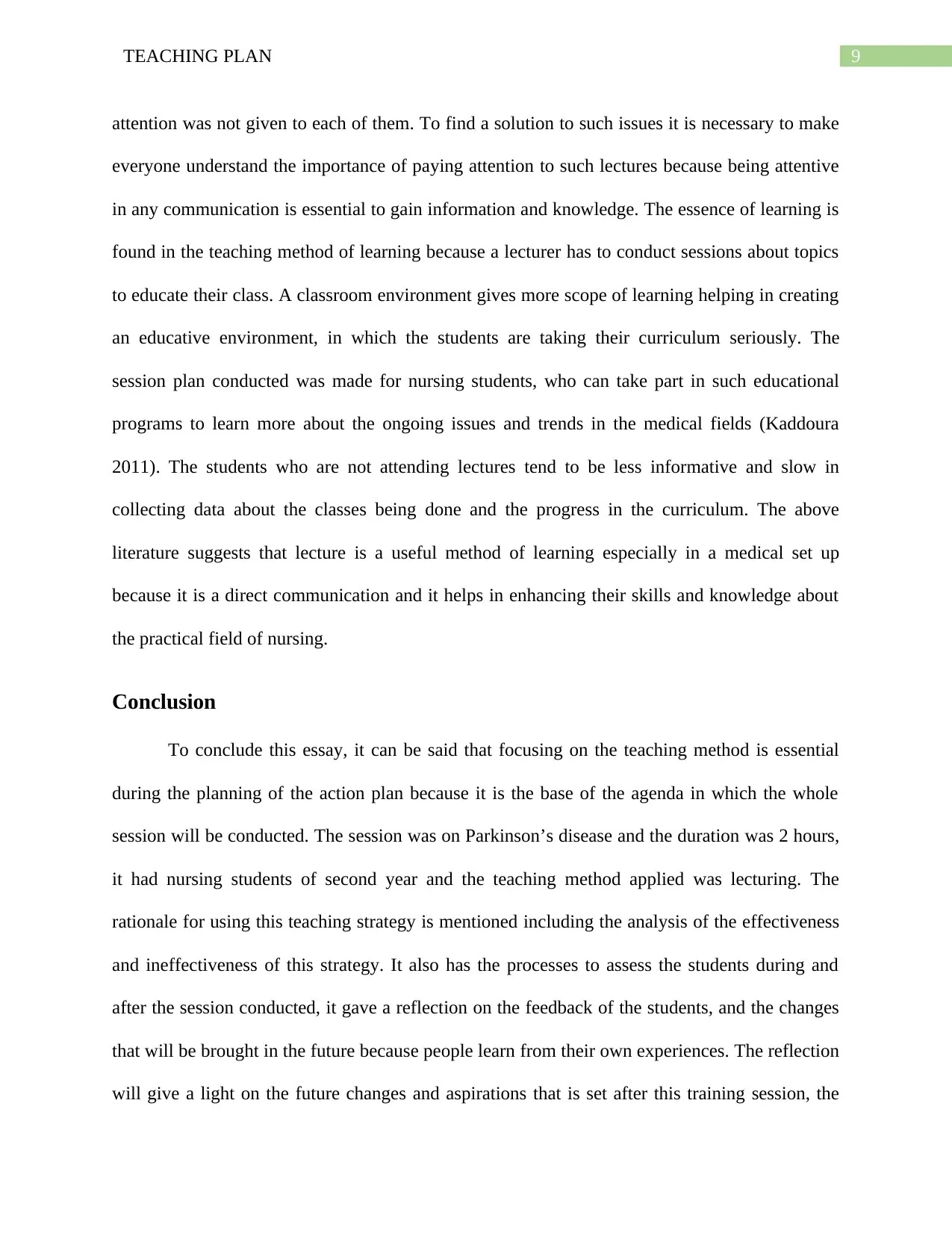
9TEACHING PLAN
attention was not given to each of them. To find a solution to such issues it is necessary to make
everyone understand the importance of paying attention to such lectures because being attentive
in any communication is essential to gain information and knowledge. The essence of learning is
found in the teaching method of learning because a lecturer has to conduct sessions about topics
to educate their class. A classroom environment gives more scope of learning helping in creating
an educative environment, in which the students are taking their curriculum seriously. The
session plan conducted was made for nursing students, who can take part in such educational
programs to learn more about the ongoing issues and trends in the medical fields (Kaddoura
2011). The students who are not attending lectures tend to be less informative and slow in
collecting data about the classes being done and the progress in the curriculum. The above
literature suggests that lecture is a useful method of learning especially in a medical set up
because it is a direct communication and it helps in enhancing their skills and knowledge about
the practical field of nursing.
Conclusion
To conclude this essay, it can be said that focusing on the teaching method is essential
during the planning of the action plan because it is the base of the agenda in which the whole
session will be conducted. The session was on Parkinson’s disease and the duration was 2 hours,
it had nursing students of second year and the teaching method applied was lecturing. The
rationale for using this teaching strategy is mentioned including the analysis of the effectiveness
and ineffectiveness of this strategy. It also has the processes to assess the students during and
after the session conducted, it gave a reflection on the feedback of the students, and the changes
that will be brought in the future because people learn from their own experiences. The reflection
will give a light on the future changes and aspirations that is set after this training session, the
attention was not given to each of them. To find a solution to such issues it is necessary to make
everyone understand the importance of paying attention to such lectures because being attentive
in any communication is essential to gain information and knowledge. The essence of learning is
found in the teaching method of learning because a lecturer has to conduct sessions about topics
to educate their class. A classroom environment gives more scope of learning helping in creating
an educative environment, in which the students are taking their curriculum seriously. The
session plan conducted was made for nursing students, who can take part in such educational
programs to learn more about the ongoing issues and trends in the medical fields (Kaddoura
2011). The students who are not attending lectures tend to be less informative and slow in
collecting data about the classes being done and the progress in the curriculum. The above
literature suggests that lecture is a useful method of learning especially in a medical set up
because it is a direct communication and it helps in enhancing their skills and knowledge about
the practical field of nursing.
Conclusion
To conclude this essay, it can be said that focusing on the teaching method is essential
during the planning of the action plan because it is the base of the agenda in which the whole
session will be conducted. The session was on Parkinson’s disease and the duration was 2 hours,
it had nursing students of second year and the teaching method applied was lecturing. The
rationale for using this teaching strategy is mentioned including the analysis of the effectiveness
and ineffectiveness of this strategy. It also has the processes to assess the students during and
after the session conducted, it gave a reflection on the feedback of the students, and the changes
that will be brought in the future because people learn from their own experiences. The reflection
will give a light on the future changes and aspirations that is set after this training session, the
Paraphrase This Document
Need a fresh take? Get an instant paraphrase of this document with our AI Paraphraser
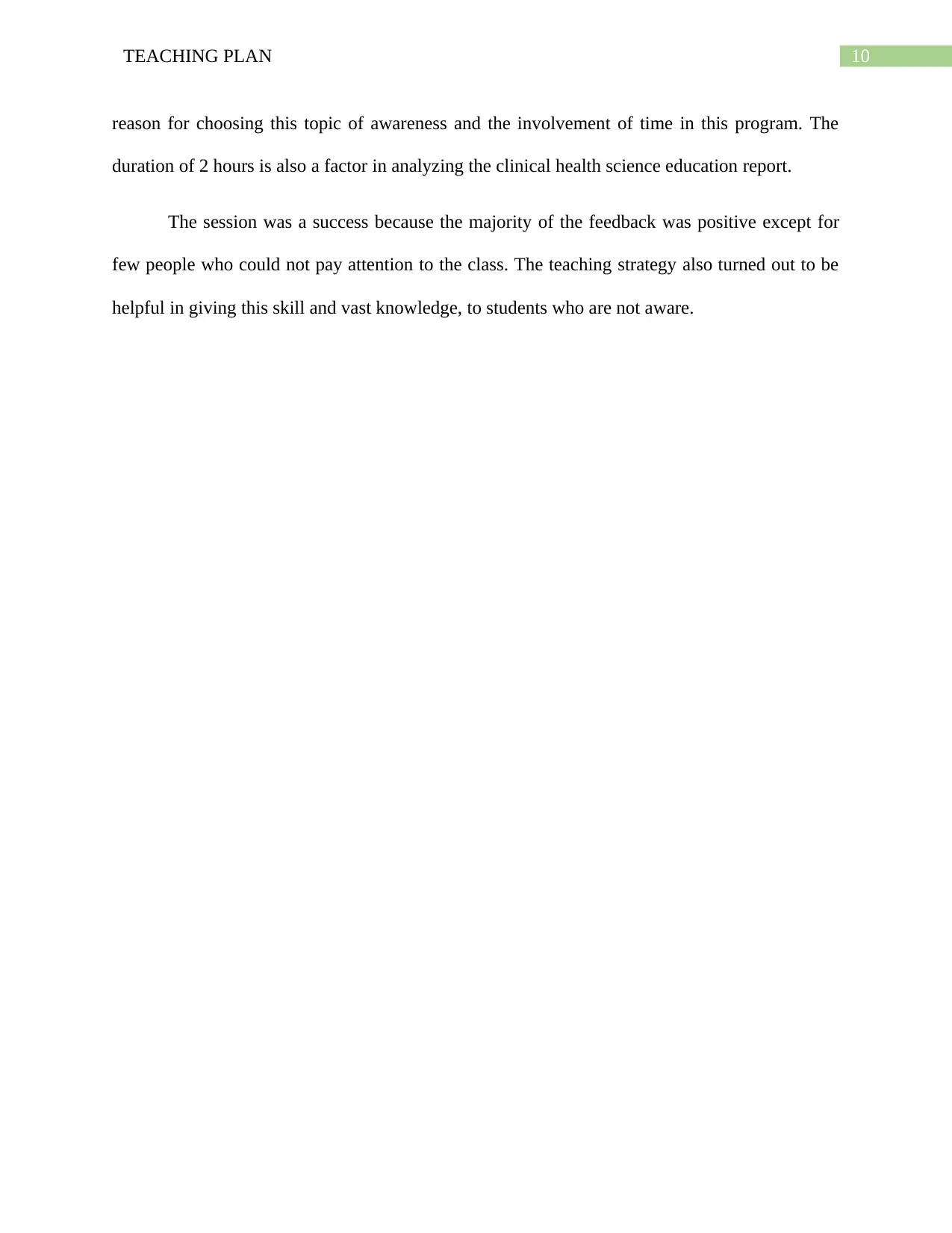
10TEACHING PLAN
reason for choosing this topic of awareness and the involvement of time in this program. The
duration of 2 hours is also a factor in analyzing the clinical health science education report.
The session was a success because the majority of the feedback was positive except for
few people who could not pay attention to the class. The teaching strategy also turned out to be
helpful in giving this skill and vast knowledge, to students who are not aware.
reason for choosing this topic of awareness and the involvement of time in this program. The
duration of 2 hours is also a factor in analyzing the clinical health science education report.
The session was a success because the majority of the feedback was positive except for
few people who could not pay attention to the class. The teaching strategy also turned out to be
helpful in giving this skill and vast knowledge, to students who are not aware.
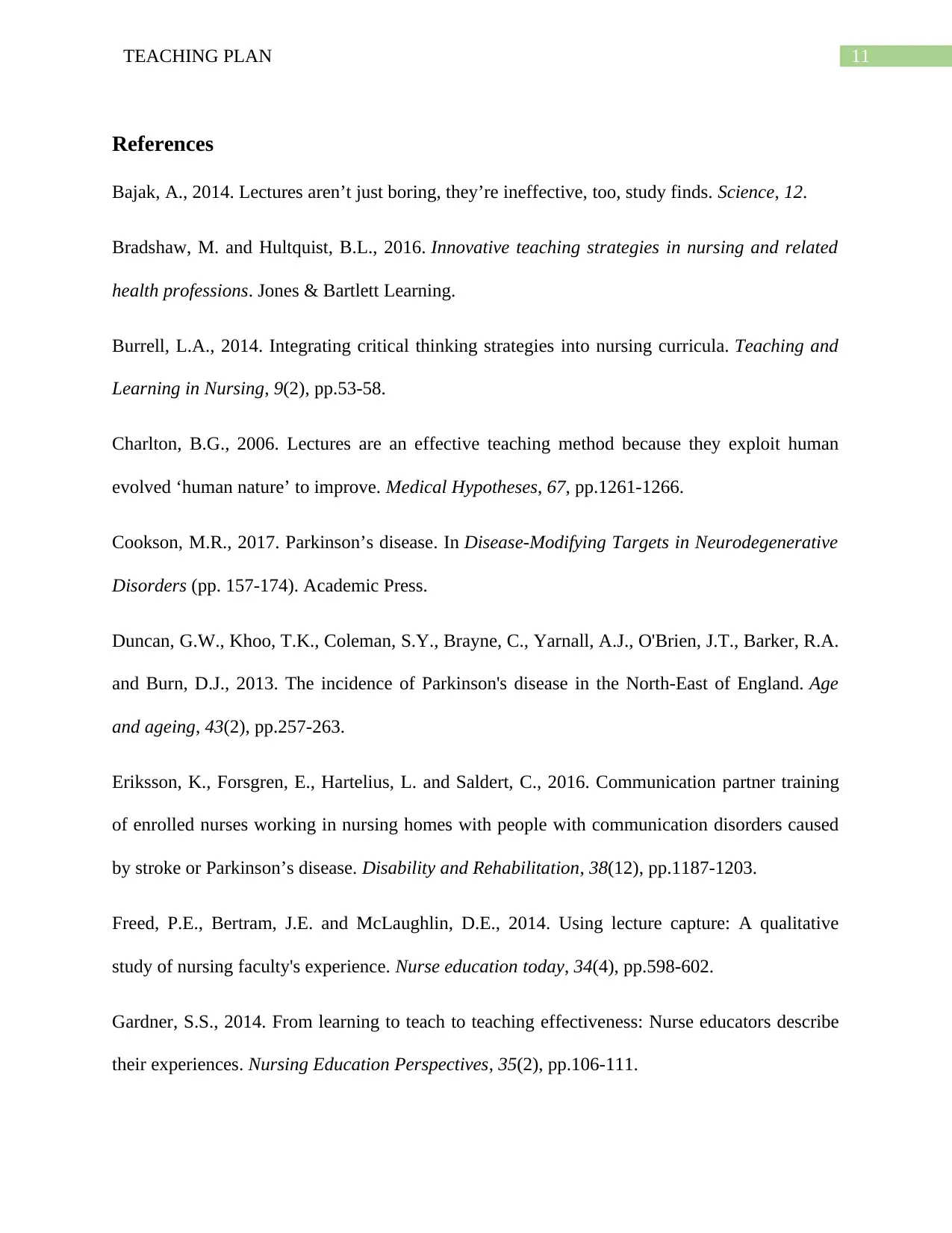
11TEACHING PLAN
References
Bajak, A., 2014. Lectures aren’t just boring, they’re ineffective, too, study finds. Science, 12.
Bradshaw, M. and Hultquist, B.L., 2016. Innovative teaching strategies in nursing and related
health professions. Jones & Bartlett Learning.
Burrell, L.A., 2014. Integrating critical thinking strategies into nursing curricula. Teaching and
Learning in Nursing, 9(2), pp.53-58.
Charlton, B.G., 2006. Lectures are an effective teaching method because they exploit human
evolved ‘human nature’ to improve. Medical Hypotheses, 67, pp.1261-1266.
Cookson, M.R., 2017. Parkinson’s disease. In Disease-Modifying Targets in Neurodegenerative
Disorders (pp. 157-174). Academic Press.
Duncan, G.W., Khoo, T.K., Coleman, S.Y., Brayne, C., Yarnall, A.J., O'Brien, J.T., Barker, R.A.
and Burn, D.J., 2013. The incidence of Parkinson's disease in the North-East of England. Age
and ageing, 43(2), pp.257-263.
Eriksson, K., Forsgren, E., Hartelius, L. and Saldert, C., 2016. Communication partner training
of enrolled nurses working in nursing homes with people with communication disorders caused
by stroke or Parkinson’s disease. Disability and Rehabilitation, 38(12), pp.1187-1203.
Freed, P.E., Bertram, J.E. and McLaughlin, D.E., 2014. Using lecture capture: A qualitative
study of nursing faculty's experience. Nurse education today, 34(4), pp.598-602.
Gardner, S.S., 2014. From learning to teach to teaching effectiveness: Nurse educators describe
their experiences. Nursing Education Perspectives, 35(2), pp.106-111.
References
Bajak, A., 2014. Lectures aren’t just boring, they’re ineffective, too, study finds. Science, 12.
Bradshaw, M. and Hultquist, B.L., 2016. Innovative teaching strategies in nursing and related
health professions. Jones & Bartlett Learning.
Burrell, L.A., 2014. Integrating critical thinking strategies into nursing curricula. Teaching and
Learning in Nursing, 9(2), pp.53-58.
Charlton, B.G., 2006. Lectures are an effective teaching method because they exploit human
evolved ‘human nature’ to improve. Medical Hypotheses, 67, pp.1261-1266.
Cookson, M.R., 2017. Parkinson’s disease. In Disease-Modifying Targets in Neurodegenerative
Disorders (pp. 157-174). Academic Press.
Duncan, G.W., Khoo, T.K., Coleman, S.Y., Brayne, C., Yarnall, A.J., O'Brien, J.T., Barker, R.A.
and Burn, D.J., 2013. The incidence of Parkinson's disease in the North-East of England. Age
and ageing, 43(2), pp.257-263.
Eriksson, K., Forsgren, E., Hartelius, L. and Saldert, C., 2016. Communication partner training
of enrolled nurses working in nursing homes with people with communication disorders caused
by stroke or Parkinson’s disease. Disability and Rehabilitation, 38(12), pp.1187-1203.
Freed, P.E., Bertram, J.E. and McLaughlin, D.E., 2014. Using lecture capture: A qualitative
study of nursing faculty's experience. Nurse education today, 34(4), pp.598-602.
Gardner, S.S., 2014. From learning to teach to teaching effectiveness: Nurse educators describe
their experiences. Nursing Education Perspectives, 35(2), pp.106-111.
⊘ This is a preview!⊘
Do you want full access?
Subscribe today to unlock all pages.

Trusted by 1+ million students worldwide
1 out of 14
Related Documents
Your All-in-One AI-Powered Toolkit for Academic Success.
+13062052269
info@desklib.com
Available 24*7 on WhatsApp / Email
![[object Object]](/_next/static/media/star-bottom.7253800d.svg)
Unlock your academic potential
Copyright © 2020–2025 A2Z Services. All Rights Reserved. Developed and managed by ZUCOL.





